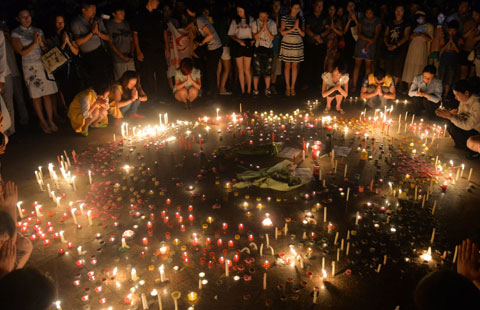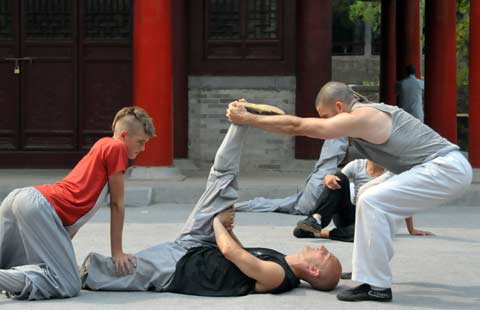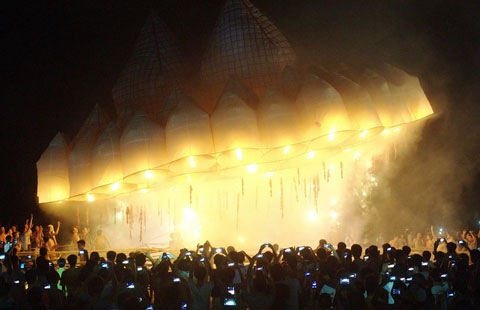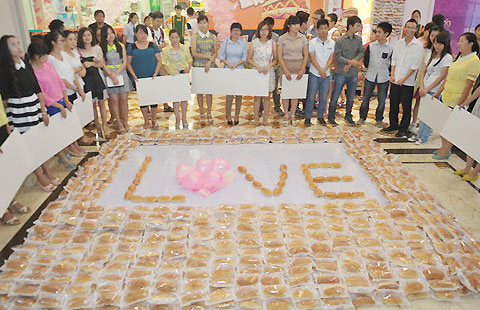Rebuilding lives
Updated: 2014-08-19 10:34
By Yang Wanli(China Daily)
|
|||||||||||
 |
|
A worker paints a staircase at Dangdai Mountain in Jiegu township of Yushu in September. The area behind him took on a new look after rebuilding efforts. Zhang Hongxiang / Xinhua |
Four years on, residents of quake-hit Yushu are receiving support to recover from the disaster but more is needed, reports Yang Wanli in Yushu, Qinghai province.
Kargu, a resident of the Yushu Tibetan autonomous prefecture in Qinghai province, gave birth to nine children at home.
"Herdsmen camp anywhere, following the grasslands with our yak and sheep. We have been accustomed to delivering our babies at home, even in tents," the 47-year-old said.
But when Kargu's own daughter Gartsok, 23, was pregnant with twins, doctors said both the babies were lying in difficult positions and needed medical attention.
So on July 30, Gartsok gave birth to the boys in the Dzatod county hospital in Yushu.
Kargu was with her daughter that day, and it was the first time for her to witness a woman giving birth in a hospital.
"Without the improvement of medical services in the county, my daughter might not have had her two sons safely," Kargu said.
Located at an average altitude of 4,200 meters, Yushu is linked to the Tibetan plateau and covers about 720,000 square kilometers with a population of about 5.7 million. Half of its residents include those from the Tibetan, Hui and Mongolian ethnic groups.
The sparsely populated prefecture has had few links with the more developed areas in central and western China. Most of its counties are connected with one-lane roads that snake through mountainou
s areas and turbulent rivers.
On April 14, 2010, a magnitude-7.1 earthquake hit Yushu city, the prefecture's capital, killing 2,698 people with 270 others still missing. Dzatod, about 250 km from the prefecture's capital, was also severely damaged in the quake.
Reconstruction and rebuilding efforts following the disaster have since helped to improve the lives of residents like Kargu and her family.
The county's hospital used to be in a single-storey brick house before the earthquake. It was the biggest hospital serving all 40,000 residents but had no more than 10 beds for patients.
"There were no separate departments in the hospital. A woman who gave birth would share the room with a patient who broke his knee," said Trashi Lhamo, assistant to the hospital chairman.
The scale and facilities of the hospital before the quake were no better than that of a residential medical center in a district in Beijing.
But after the tremor struck, the Red Cross Society of Shanxi province donated about 30 million yuan ($4.88 million) to rebuild the county's hospital with new facilities and medical equipment.
The hospital now boasts a three-storey building covering 4,000 sq m and 30 beds. New mothers like Gartsok can enjoy a good rest with her babies in a room for new mothers. A doctor will visit her three times a day, checking both her health and the condition of the babies.
"I will recommend my sisters to deliver in the hospital, whether their medical conditions are normal or complicated," Gartsok said.
Yushu enjoys only four months of warm days in the whole year, with the highest temperature at about 20 C in the day. The rest of the days are cold and there are still no electrical or water heating systems in many homes.
"The inpatient rooms in the new hospital have air conditioners. It is much more comfortable to give birth here," Gartsok said.
With medical insurance, patients need to pay only about 20 percent of all medical costs. Gartsok, who went through c-section surgery and stayed in the hospital for eight days, paid no more than 1,000 yuan for the treatment, an amount similar to about one month's average income for a worker in the county.
Helping hands
A total of 2.6 billion yuan was donated to the Red Cross Society of Qinghai for rebuilding work after the quake, which formed a major part of the prefecture's rebuilding budget, figures from the Red Cross Society of China showed.
About 2.3 billion yuan of the donations came from the Red Cross Society of China. About 2 billion yuan of the funds for some projects remain under construction.
The donations covered a total of 94 reconstruction projects, among which 75 have been put into use.
Residents were in crucial need of healthcare services following the quake and 45 of all rebuilding projects are related to medical facilities such as hospitals in the cities and counties as well as clinics in the townships.
Yushu Prefecture People's Hospital in Yushu city is the largest hospital in the prefecture. The hospital's old building was leveled in the earthquake and it was rebuilt on the original site in 2010. With a 184 million yuan donation from the Aluminum Corporation of China, the hospital now includes a new building covering 32,300 sq m.
"The new facility is five times bigger than the old one. It's also the first time for us to have a real emergency department," said Liang Xiuyin, 40, head nurse of the emergency department.
Liang said the new hospital also boasts facilities like nuclear magnetic resonance and CT scanning machines. Before that, patients who needed related medical checks had to go to Xining, the provincial capital, which lies 800 km in the northeast of Yushu.
Liang said the prefecture opened its first airport in 2009.
"Before that, the only way to go to Xining was by bus, which took about 18 hours. In the 1990s, traveling by bus between the two places took two days," she said.
"We even didn't have an ambulance, just two minivans for the emergency cases. The only medical equipment in them were stretchers," she said.
"Hundreds of patients who were severely injured in the earthquake were lying in the tents in the garden of the hospital. The building collapsed and we could not provide better conditions."
The new emergency department has 18 employees and five ambulances. Liang and her other colleagues also have more opportunities to learn from doctors from the country's top hospitals.
She visited the Beijing Emergency Treatment Center in May 2012 and learned the latest emergency rescue techniques for three months.
Liang said she lost a number of family members in the quake and times were tough in the immediate aftermath of the disaster.
"Things have been getting better in the past four years. Early after the earthquake, we rarely smiled," Liang said.
"But life should move on. I used to admire the good facilities and working circumstances in Xining. Now we also have those. During our visits to Beijing, the strong feelings of being cared for and loved also inspired me. You can see smiles returning to our faces," she said.
Today's Top News
Chinese firms keep UK auto industry ticking
Rebels kill civilians as talks fail
Probes 'won't deter investors'
China, France collaborate on virus research lab
'Sky Road' finally connects Tibetan villages
Hospitals intervene to prevent suicides
No word if GM rice certificates extended
Drug bust for Jackie Chan's son
Hot Topics
Lunar probe , China growth forecasts, Emission rules get tougher, China seen through 'colored lens', International board,
Editor's Picks

|

|

|

|

|

|





